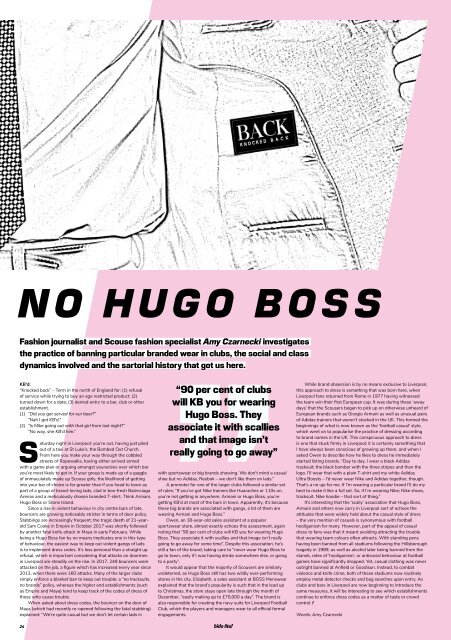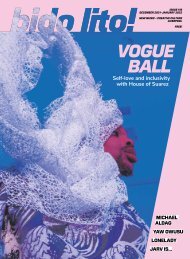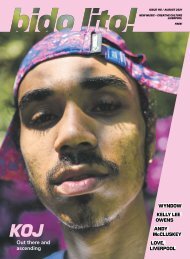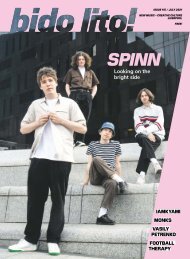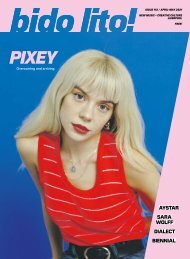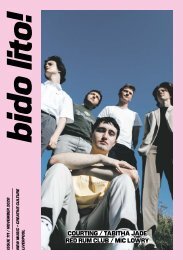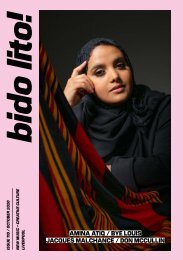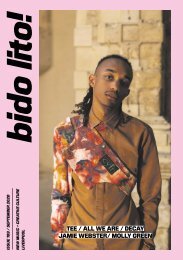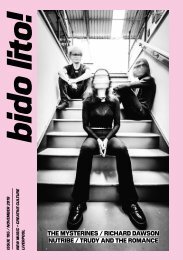Issue 96 / February 2019
February 2019 issue of Bido Lito! magazine. Featuring: EYESORE & THE JINX, LADYTRON, LEE SCOTT, ERIC TUCKER, INTERNATIONAL TEACHERS OF POP, KYAMI, RAY MIA, YVES TUMOR, BILL RYDER-JONES and much more.
February 2019 issue of Bido Lito! magazine. Featuring: EYESORE & THE JINX, LADYTRON, LEE SCOTT, ERIC TUCKER, INTERNATIONAL TEACHERS OF POP, KYAMI, RAY MIA, YVES TUMOR, BILL RYDER-JONES and much more.
Create successful ePaper yourself
Turn your PDF publications into a flip-book with our unique Google optimized e-Paper software.
NO HUGO BOSS<br />
Fashion journalist and Scouse fashion specialist Amy Czarnecki investigates<br />
the practice of banning particular branded wear in clubs, the social and class<br />
dynamics involved and the sartorial history that got us here.<br />
KB’d:<br />
“Knocked back” – Term in the north of England for: (1) refusal<br />
of service while trying to buy an age restricted product; (2)<br />
turned down for a date; (3) denied entry to a bar, club or other<br />
establishment.<br />
(1) “Did you get served for our beer?”<br />
“Nah I got KB’d.”<br />
(2) “Is Mike going out with that girl from last night?”<br />
“No way, she KB’d him.”<br />
Saturday night in Liverpool: you’re out, having just piled<br />
out of a taxi at St Luke’s, the Bombed Out Church.<br />
From here you make your way through the cobbled<br />
streets of Ropewalks, having either arrived armed<br />
with a game plan or arguing amongst yourselves over which bar<br />
you’re most likely to get in. If your group is made up of a gaggle<br />
of immaculately made up Scouse girls, the likelihood of getting<br />
into your bar of choice is far greater than if you head to town as<br />
part of a group of brand-loving lads, clad in box-fresh Balenciaga<br />
Arenas and a meticulously chosen branded T-shirt. Think Armani,<br />
Hugo Boss or Stone Island.<br />
Since a rise in violent behaviour in city centre bars of late,<br />
bouncers are growing noticeably stricter in terms of door policy.<br />
Stabbings are increasingly frequent; the tragic death of 21-yearold<br />
Sam Cooke in Empire in October 2017 was shortly followed<br />
by another fatal knife attack in Maya in early <strong>February</strong>. While<br />
being a Hugo Boss fan by no means implicates one in this type<br />
of behaviour, the easiest way to keep out violent gangs of lads<br />
is to implement dress codes. It’s less personal than a straight up<br />
refusal, which is important considering that attacks on doormen<br />
in Liverpool are steadily on the rise. In 2017, 249 bouncers were<br />
attacked on the job, a figure which has increased every year since<br />
2013, when there were 160 attacks. Many of the larger clubs<br />
simply enforce a blanket ban to keep out trouble; a “no tracksuits,<br />
no brands” policy, whereas the higher end establishments (such<br />
as Empire and Maya) tend to keep track of the codes of dress of<br />
those who cause trouble.<br />
When asked about dress codes, the bouncer on the door of<br />
Maya (which had recently re-opened following the fatal stabbing)<br />
explained: “We’re quite casual but we don’t let certain lads in<br />
“90 per cent of clubs<br />
will KB you for wearing<br />
Hugo Boss. They<br />
associate it with scallies<br />
and that image isn’t<br />
really going to go away”<br />
with sportswear or big brands showing. We don’t mind a casual<br />
shoe but no Adidas, Reebok – we don’t like them on lads.”<br />
A promoter for one of the larger clubs followed a similar set<br />
of rules: “If you’ve got Nike trainers like Huaraches or 110s on,<br />
you’re not getting in anywhere. Armani or Hugo Boss, you’re<br />
getting KB’d at most of the bars in town. Apparently, it’s because<br />
these big brands are associated with gangs, a lot of them are<br />
wearing Armani and Hugo Boss.”<br />
Owen, an 18-year-old sales assistant at a popular<br />
sportswear store, almost exactly echoes this assessment, again<br />
noting that “90 per cent of clubs will KB you for wearing Hugo<br />
Boss. They associate it with scallies and that image isn’t really<br />
going to go away for some time”. Despite this association, he’s<br />
still a fan of the brand, taking care to “never wear Hugo Boss to<br />
go to town, only if I was having drinks somewhere else, or going<br />
to a party”.<br />
It would appear that the majority of Scousers are similarly<br />
undeterred, as Hugo Boss still has two wildly over-performing<br />
stores in the city. Elizabeth, a sales assistant at BOSS Menswear<br />
explained that the brand’s popularity is such that in the lead up<br />
to Christmas, the store stays open late through the month of<br />
December, “easily making up to £70,000 a day”. The brand is<br />
also responsible for creating the navy suits for Liverpool Football<br />
Club, which the players and managers wear to all official formal<br />
engagements.<br />
While brand obsession is by no means exclusive to Liverpool,<br />
this approach to dress is something that was born here, when<br />
Liverpool fans returned from Rome in 1977 having witnessed<br />
the team win their first European cup. It was during these ‘away<br />
days’ that the Scousers began to pick up on otherwise unheard of<br />
European brands such as Giorgio Armani as well as unusual pairs<br />
of Adidas trainers that weren’t stocked in the UK. This formed the<br />
beginnings of what is now known as the ‘football casual’ style,<br />
which went on to popularise the practice of dressing according<br />
to brand names in the UK. This conspicuous approach to dress<br />
is one that stuck firmly in Liverpool; it is certainly something that<br />
I have always been conscious of growing up there, and when I<br />
asked Owen to describe how he likes to dress he immediately<br />
started listing brands. “Day to day, I wear a black Adidas<br />
tracksuit; the black bomber with the three stripes and then the<br />
logo. I’ll wear that with a plain T-shirt and my white Adidas<br />
Ultra Boosts – I’d never wear Nike and Adidas together, though.<br />
That’s a no-go for me. If I’m wearing a particular brand I’ll do my<br />
best to make it like a full set. So, if I’m wearing Nike; Nike shoes,<br />
tracksuit, Nike hoodie – that sort of thing.”<br />
It’s interesting that the ‘scally’ association that Hugo Boss,<br />
Armani and others now carry in Liverpool sort of echoes the<br />
attitudes that were widely held about the casual style of dress<br />
– the very mention of casuals is synonymous with football<br />
hooliganism for many. However, part of the appeal of casual<br />
dress to fans was that it meant avoiding attracting the trouble<br />
that wearing team colours often attracts. With standing pens<br />
having been banned from all stadiums following the Hillsborough<br />
tragedy in 1989, as well as alcohol later being banned from the<br />
stands, rates of ‘hooliganism’, or antisocial behaviour at football<br />
games have significantly dropped. Yet, casual clothing was never<br />
outright banned at Anfield or Goodison. Instead, to combat<br />
violence and knife crime, both of these stadiums now routinely<br />
employ metal detector checks and bag searches upon entry. As<br />
clubs and bars in Liverpool are now beginning to introduce the<br />
same measures, it will be interesting to see which establishments<br />
continue to enforce dress codes as a matter of taste or crowd<br />
control. !<br />
Words: Amy Czarnecki<br />
24


